
 |
| Tel: +1 (503)635-4243 - Email: robert@oshatz.com |
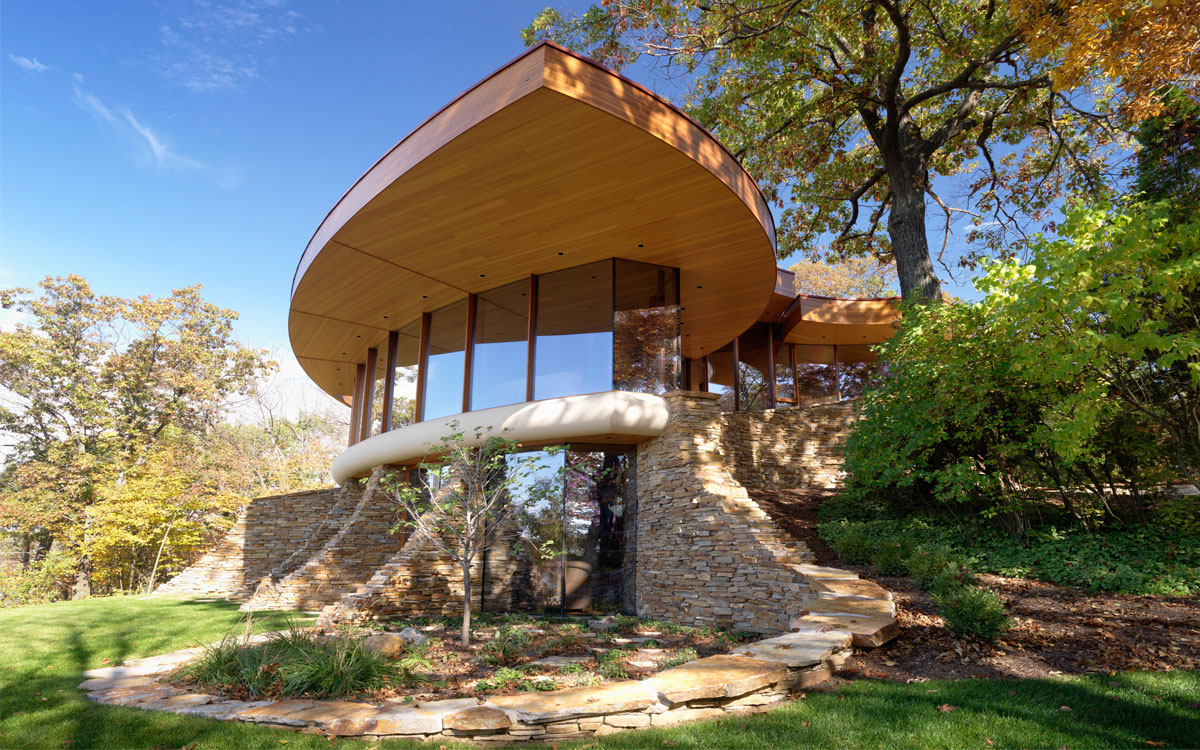 |
||
|
CHENEQUA RESIDENCE Milwaukee, Wisconsin - 2011 |
||
|
On a heavily wooded site adjacent to a lake in Milwaukee’s western fringe, Robert Oshatz was asked to design a home for a growing family. The site originally contained a house that was unsuitable for the family’s needs which needed to be demolished, but the owners recognized the site’s natural beauty and stressed that it was very important to them that all the trees that existed on the site be retained. The clients wanted a building, built from natural materials, that acted as one with its environment, and provided unobstructed views and connections to the surrounding landscape. Oshatz has developed a reputation for creating architecture that is inspired by its environment. His projects; built across 5 US states and in Japan are each unique responses to the site of the building, and to the requirements and personality of the clients. When asked about his approach to architecture Oshatz states that he believes that “architecture should be at peace with its environment while the occupants are at peace within”. The clients were drawn to Oshatz’s exciting and dynamic forms and to his integration and respect for the surrounding environment. |
||
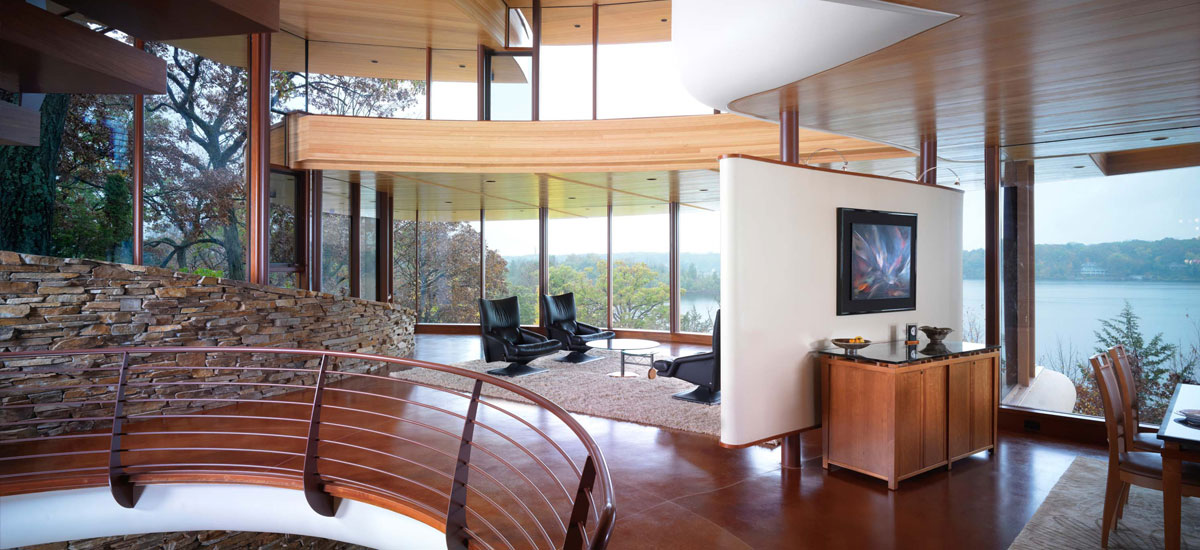 |
||
|
From the street there is little to suggest that the Chenequa Residence exists. A single lane drive, surrounded by trees turns off street and runs through corn fields on either side, as it continues it becomes increasingly wooded with stands of oak trees. In the early hours of the morning it is not uncommon to encounter deer or wild turkeys while following the road. The approach to the house leads up a small hill and onto a circular driveway that was retained from the previous house. On ascending the hill, the Chenequa residence emerges from across a grassed yard. From first encounter the house appears to be small; its stepping roof and spiralling stone columns help to reduce its scale and obscure its size. Oshatz uses the geometry of the house to continually hide and expose new parts of the building, creating interest and concealing its scale at the same time. From no single angle is it possible to comprehend the building as a whole. The approach to the house follows a small stone wall which continues underneath a low cedar clad roof. Upon walking through the glass door, the compression of the low entry explodes into a celebration of light and form. A large circular opening in the floor exposes a whole new level below, the low roof lifts and spins out of view and is followed by a cantilevered staircase. A solid stone core stands at the centre of it all, like a choreographer directing the dance around it. The entry into the house also allows for an interesting juxtaposition of environments. The approach to the house is down a driveway surrounded by trees, and across a lawn that feels like a meadow amongst a forest, but by entering the house, the lake finally becomes visible and dominates the view from inside the house. Endless floor to ceiling glass displays the lake while roof and floor planes appear to career outwards toward it. Yet even though the house explores these two separate environments, it never feels stuck between them. The removal of structure from the glazing line, the careful continuation of materials through the glazing, and the spiral shape of the house; which creates a space that has no directional emphasis, ensure that connections to the exterior are provided in all directions, and that the house becomes a celebration of both the forest and the lake. |
||
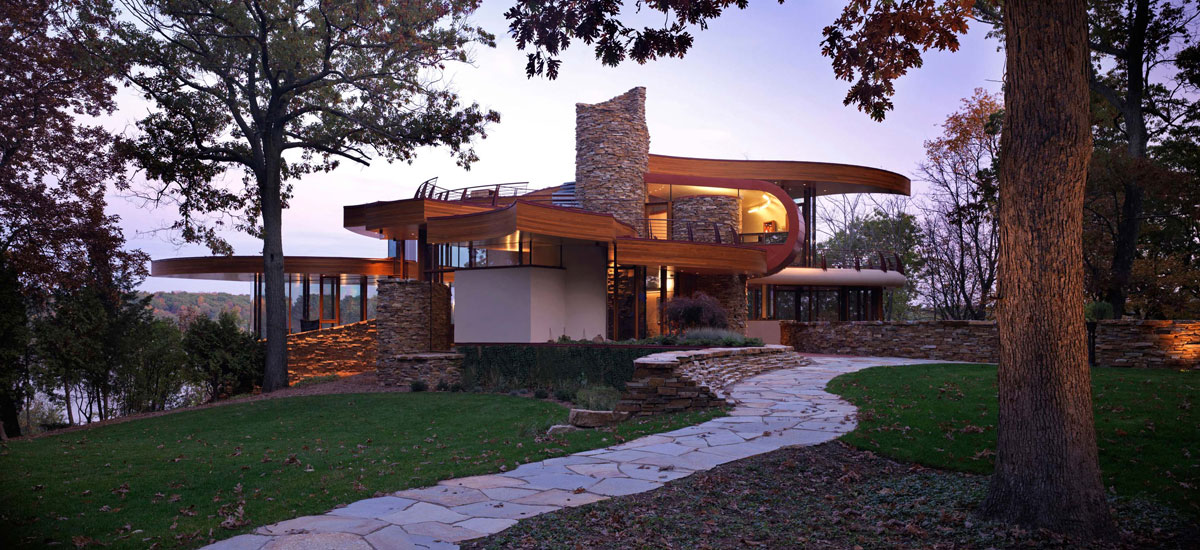 |
||
|
By building the house into the site, entrance to the house is made on the second of three floors. The entry level is provided with unobstructed views to the lake and accommodates the public spaces of the house including lounge room, dining room and kitchen. These spaces are separated from the main atrium by low ceilings which help to provide an intimate environment. The plan of the wraps itself around the convex curve of the site, which when combined with the use of floor to ceiling glass ensures that magnificent lake views are seen from all the internal spaces. The floor plan is continued out through the kitchen and onto a cantilevered deck which extends out amongst the trees. A ribbon of curved steel balustrades bends itself around the balcony and returns into a heavy stone garden wall, effectively tying the floating floor plain back to the earth. On the other side of the house, the helical stone wall that defines the lounge room twists around a tall oak tree and ties the floor back to the ground in a similar fashion. The floor below the entry level is used for more family based functions. Below the main atrium space is a games room, a small bar, a theatre room and a small study. In the wing that follows under the kitchen are the children’s bedrooms and a guest room. The communal family spaces are dug below the ground and where they open up to the exterior, the view is always filtered by heavy stone walls. The children’s bedrooms are afforded elevation and views by virtue of the sloping site but are bound by stone and anchored to the ground. The circulation on the bottom floor is also much more guarded than that provided to the public spaces above. The bedrooms are accessed via a tall but thin corridor adorned only with highlight windows. As one of the few spaces in the house without commanding views, the corridor provides a sense of security and warmth. Unlike the main atrium space, the bedrooms are more conventionally scaled and shaped, they provide views to the lake, but only in one direction. The bedroom at the end of the corridor is ensured privacy by its height as the building grows out of the hill, but is provided with an added sense of protection created by the oversized expanse of ceiling to the underside of the deck which extends out from the kitchen. Where the entry level is dedicated to public functions and provided with views and open space, the family oriented rooms on the floor below are provided with a sense of warmth and security. |
||
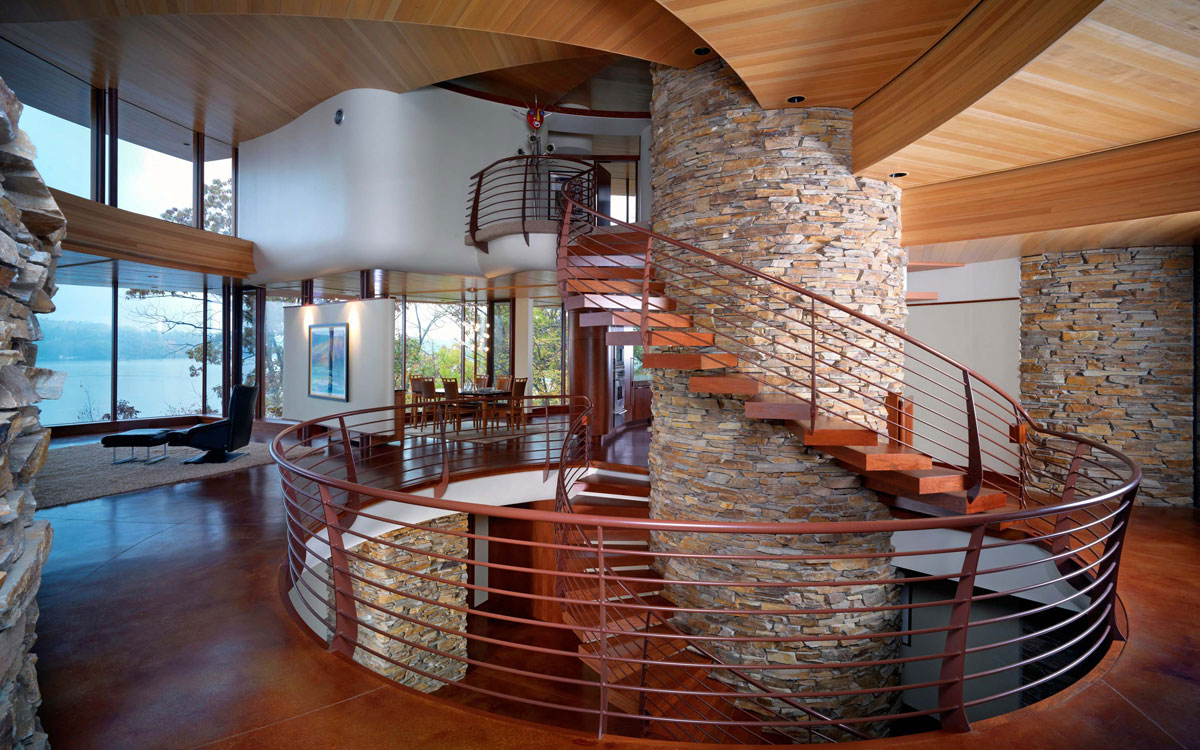 |
||
|
The floor above the entry level is dedicated to the master suite and includes a master bedroom, ensuite and a nursery. From the atrium, the upper floor appears as a floating volume which wraps around the stone elevator column. The carpeted floor, which differs from the stained concrete on the flower floors helps to isolate the upper floor from the lower levels. A planted balcony extends out from the master bedroom, helping to enhance the floating feeling. The Bedroom and nursery are both provided with frameless glass which gives uninterrupted views to the lake and the tree canopy, yet as the stepping spiral room sweeps up over the main atrium it passes over the rooms at a low level; ensuring that they maintain a sense of warmth and protection. The master ensuite is built into a tubular shape that radiates out from the elevator core. The enclosed feeling of the ensuite provides a counterpoint to the openness of the master bedroom. From the upper floor, a door opens out onto the roof segment that hangs over the main entry to the house. As the roof spirals around the stone elevator core, steps follow the roofs, turning each roof into a terraced garden. Some roofs of the roofs are fully, while others have paved areas for a deck chair and umbrella. The highest roof section is about 8ft above the lake and provides commanding views. The clients had expressed at an early stage that they did not appreciate symmetry. Oshatz removed any need for symmetry by utilizing a radial plan for the house. The plan consists of a series of radiuses, with a number of different centre points, yet to achieve a logical and harmonious plan throughout the house, each radius is related. The primary radius wraps itself around the contours of the site, on a path that avoids the need to remove any trees. This radius also maintains a convex aspect to the lake, which helps to make the house feel as if it opening up to the views and the landscape around it. The main axis is centred on a large oak tree that dominates the site. Each subsequent radius responds to the geometry of the others, resulting is spaces that feel at the same time free flowing, and harmonious. |
||
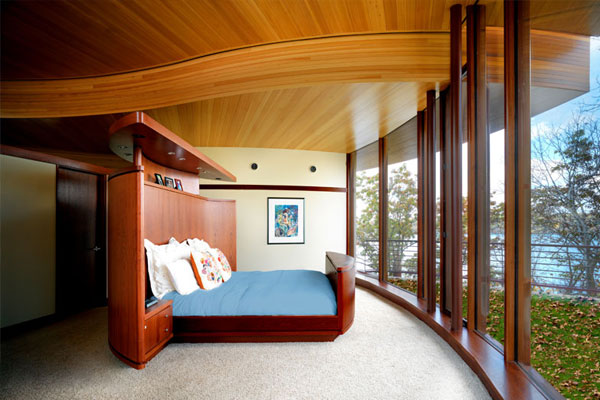 |
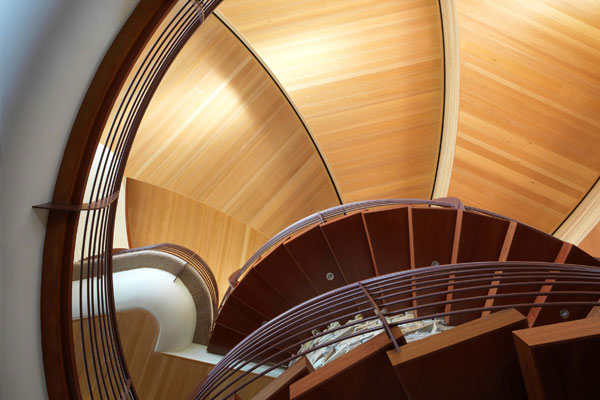 |
|
|
The house was designed to be visually small from the entry way, but to utilize the steep slope of the site to provide maximum views and connections to the lake. The resultant structure emerges from the earth as a series of planes that glide along face of the hill side. Each plane is unique, and no plane exactly follows any other; they appear to be light weight and are separated only by glass. The roof planes, with a different materiality, spin in a different pattern to the floor planes, helping to provide intreuge and complexity to the design. The lightweight and energetic horizontal planes are countered by the vertical stone volumes that appear to grow from the earth and help to anchor the building. The pallet of materials is limited to a few that were chosen for the natural beauty, and their ability to tie the building into the natural environment. The three primary materials used on the house are cedar for the ceilings, Idaho stone chosen for its unique colour and shimmer, and concrete floors which have been stained a rusty earth colour. Plasterboard is used as a secondary material; it has a lightweight feel that acts in contrast to the heavy, anchoring, stone clad walls and is used to maintain the light and independent feeling of the horizontal floor planes, while providing the necessary privacy between rooms. Stucco is used to highlight the edges of the floor planes and to define the upper floor volume. Painted metal is used to clad the master ensuite tube which appears as an independent volume. The flow of space between the interior of the building and the exterior was of primary concern during the design of the Chenequa Residence. It is widely understood that connections with natural environments have very positive outcomes for residence, and given the idealic setting that the house is sited, it became even more important that occupants felt connected with their surrounding environment, and not isolated in within the structure. Floor to ceiling glass is used extensively throughout the house and helps to provide views, but it is the continuation of materials through the glazing lines that help to break down the boundaries between interior and exterior. Traditional window framing details have been replaced by frames that are concealed within the structure, and behind the finish material, allowing the material to run unaffected from the interior to the exterior. This helps to dissolve the boundaries of the space. The removal of the structure from the building skin is also helpful as columns are brought within the glazing line and can no longer reinforce the interior/exterior boundary. The horizontal planes that appear as independent volumes, and which never follow each other exactly help to confuse the boundary of the building. In some circumstances it is even difficult to identify exactly where the window glass is located. |
||
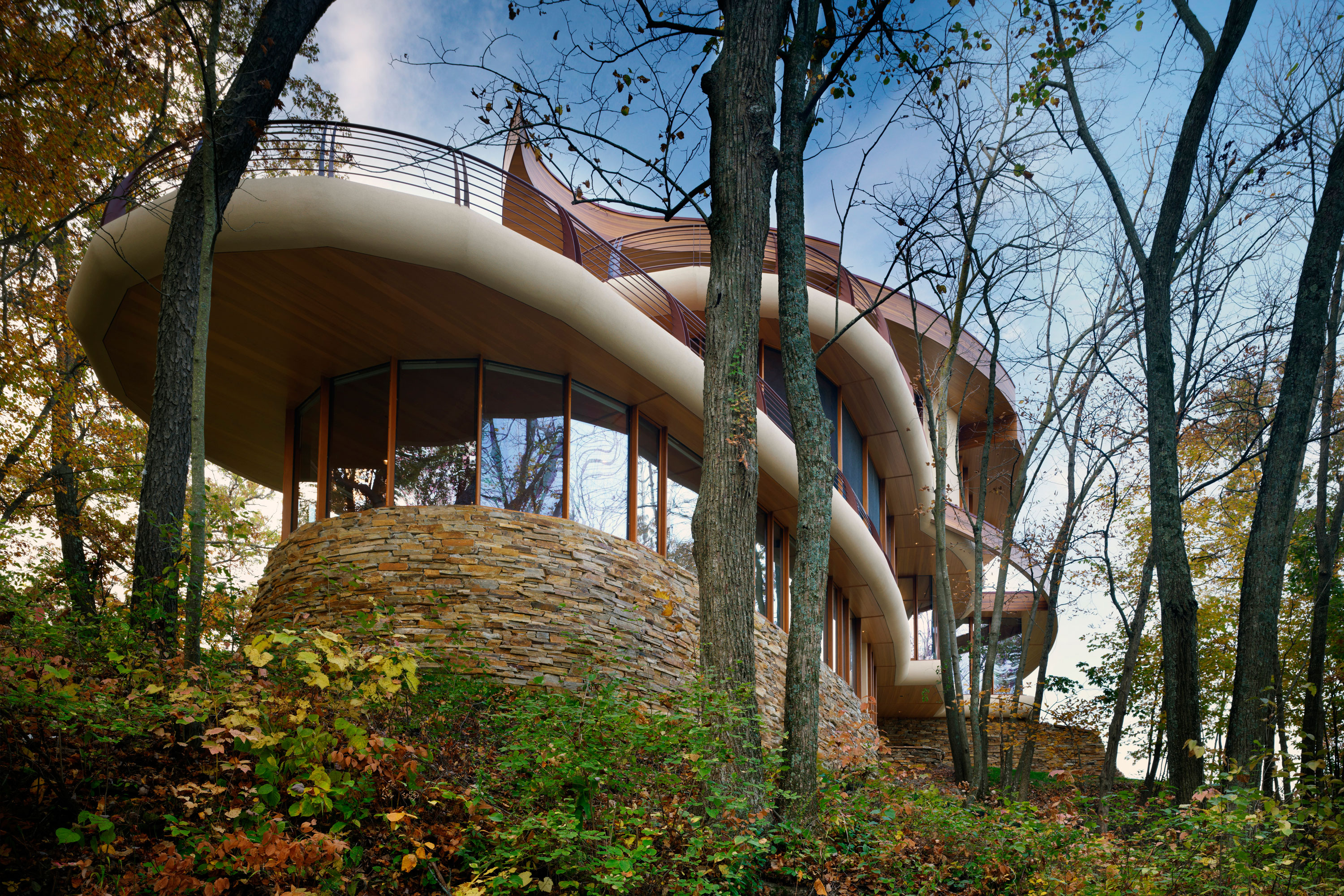
|
||
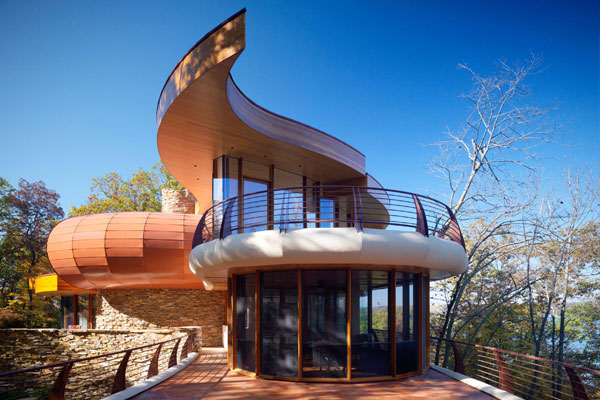 |
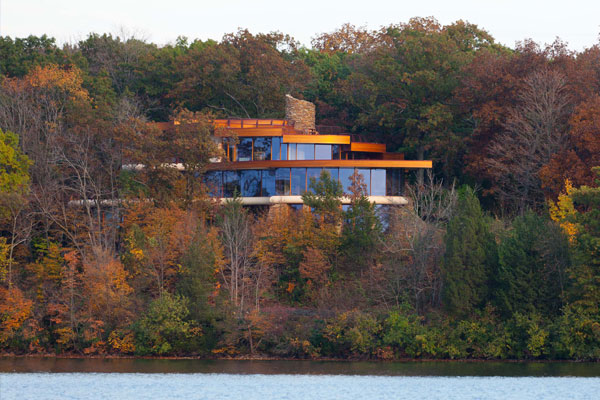 |
|
|
|
||